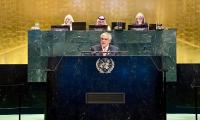As China marks the 75th anniversary of the founding of the People’s Republic, it stands as a testament to an extraordinary transformation.
From the ruins of civil war in 1949, China emerged battered and impoverished, with few expecting the nation would rise to such global prominence. Over the past seven decades, China’s leaders have orchestrated a remarkable transformation, lifting over 800 million citizens out of poverty and positioning the country as the world’s second-largest economy.
But this achievement is more than just economic; it reflects a strategic vision rooted in resilience and innovation. China’s rise has not only reshaped its domestic landscape but also redefined its role on the global stage, turning it into an indispensable partner in global development and a pivotal force in shaping the future of international cooperation.
China’s remarkable economic growth is no accident – it is the result of a bold and strategic shift that began in the late 1970s. With the adoption of reform and opening-up policies, China embraced trade liberalisation, foreign investment, and rapid industrialisation. The country tapped into its vast labour force and rich natural resources, creating an economic powerhouse that now accounts for 18 per cent of global GDP.
In 2023, with a growth rate of 5.2 per cent, China solidified its role as a stabilising force in the global economy. But China’s rise goes beyond its borders. As the world’s largest trading nation, China has become the top trading partner for over 120 countries.
By 2022, China had cemented its position as the second-largest destination for foreign direct investment (FDI), reflecting its central role in global supply chains and manufacturing. China’s integration into the global economy is not just an achievement but a defining force for global commerce.
China’s rise has shattered long-held beliefs that many emerging nations once clung to. For decades, countries in South Asia, Africa, and elsewhere accepted the notion that catching up with developed economies was a near-impossible feat. The result? Waves of migration to the West in search of better opportunities. China, however, proved this narrative wrong.
In just a few decades, it demonstrated that rapid economic growth is attainable – without having to rely on the traditional model of resource extraction that has long dominated the global economy. China’s success wasn’t built on the idea that one nation’s gain must come at another’s loss. Rather, it was driven by internal reforms and the efficient use of existing resources. From telecommunications and LED technology to solar power and electric vehicles, China’s approach has been to create affordable, high-quality products on a massive scale.
More importantly, China has made this technology accessible to the world, even subsidizing it in certain cases to ensure widespread adoption. The lesson here is profound: China’s model shows that a nation can leverage its indigenous capabilities, foster equitable growth, and, in turn, challenge the status quo of global development. This approach has not only benefited China but offered a blueprint for other nations seeking to redefine their own economic futures. It’s a shift in thinking that could reshape how the world approaches growth and prosperity.
As China commemorates the 75th anniversary of the founding of the People’s Republic, the world finds itself reflecting on an economic ascent that has defied expectations and shattered myths. A report titled ‘China’s 75-Year Journey: Breaking Myths & Inspiring Hope’ by KTrade Securities, a leading brokerage in Pakistan, sheds light on this remarkable trajectory – one marked by both speed and consistency, but also by a profound and inclusive global impact.
In the face of trade disputes with the US, the report offers a sobering reminder: economic rationality, in the long run, always prevails. Countries cannot be forced into decisions that work against their self-interest. China’s growth is rooted in the belief that mutual prosperity is key. If other nations thrive, China thrives. This symbiosis has reshaped global economic relations, particularly with emerging economies like BRICS.
In 1995, the F7 countries accounted for 44.9 per cent of global GDP, while BRICS held a modest 16.9 per cent. Fast forward to 2023, and the balance has shifted dramatically – BRICS now contributes 36.9 per cent of global GDP, outpacing the F7, which has fallen to 29.9 per cent.
China’s relationship with BRICS has been transformative, reflecting its belief that collaboration, not conflict, fuels sustainable growth. This rise is not just a story of national development; it is a reimagining of how global economies can work together, reshaping not only statistics but the very structure of power in the 21st century.
According to this report, China has pivoted from a manufacturing-based economy to one rooted in services and advanced industries, a move aimed not only at economic stability but also environmental sustainability. This shift is no small feat. China is pouring resources into emerging technologies like artificial intelligence, 5G, and renewable energy, signaling its ambitions to lead the global tech landscape by 2030.
The country’s focus on sectors like solar energy and automation – areas where it already holds a commanding position – underscores this transformation. Remarkably, sectors tied to the ‘new economy’, including automation, green energy, and AI, now account for 55 per cent of GDP growth, even though they comprise just 20 per cent of the overall economy. This isn’t just a technological shift; it’s a profound restructuring of China’s economic foundation, setting the stage for long-term growth. The early and aggressive investment in these dynamic sectors places China on a trajectory that could shape the future of global innovation.
By prioritising sustainability and forward-thinking industries, China isn’t just securing its place in the next economic chapter - it’s writing it. What some may view as a threat to the current global order, China sees as a necessary evolution toward a more equitable, technologically advanced world. And in that future, China intends to lead.
While China’s manufacturing might continues to power its economy, its rapid ascent in science and technology is equally staggering. Over the past decade, the country has become a formidable force in emerging fields like artificial intelligence, 5G, robotics, and nano-manufacturing. The Australian Strategic Policy Institute even reports that China now outpaces the US in 37 out of 44 critical tech areas, including hypersonic missiles, AI, and quantum computing.
This technological leap didn’t happen by accident; it was driven by aggressive investments in research and development and a concerted effort to foster local talent. China’s openness to foreign businesses has also played a key role. By creating an environment conducive to international companies, China has facilitated the transfer of cutting-edge technology and capital, accelerating its transformation from a manufacturing-based economy to one centered around innovation.
Today, China is not just the world’s manufacturing hub; it produces more than the next nine largest manufacturers combined. Its integration into global supply chains is so deep that it has become an indispensable partner for nations and corporations alike.
Far from retreating inward, China has embraced a future where its technological leadership stands alongside its manufacturing dominance, positioning itself as a critical player in shaping the next wave of global innovation. As the country continues to blend its industrial strength with scientific prowess, it redefines what it means to be a superpower in the 21st century.
The writer is a freelance contributor.
Palestinians gather to receive food from a charity kitchen, amid a hunger crisis, in Gaza City on July 23, 2025. —...
Taliban spokesman Zabiullah Mujahid participates in a press conference at the government media and information center...
Screengrab of viral video shows tribal members carrying out “honour killing” at unknown location in Balochistan....
An employee of an Exchange Bank counts one hundred US dollar notes during a photo opportunity at the bank's...
An employee counts Pakistani rupee notes at a bank in Peshawar, on August 22, 2023. — ReutersPakistan has posted a...
A graphical poster of ‘Bunyad’, an Urdu-language journal published by the LUMS. — Bunyad LUMHS website/FileA...







